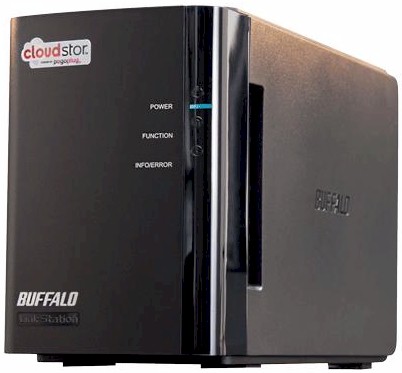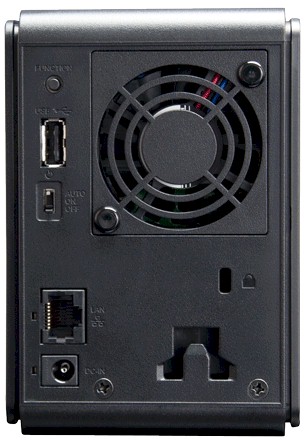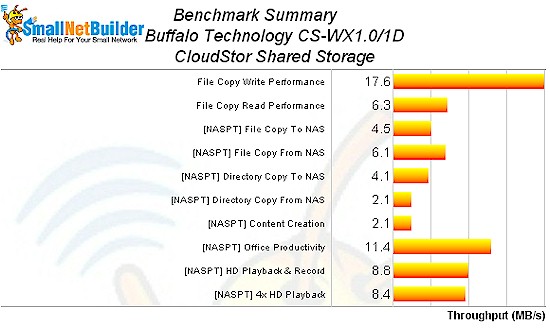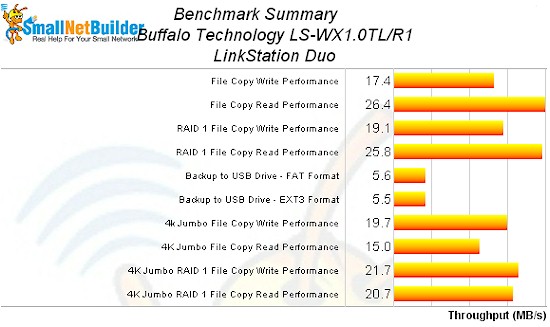The Buffalo CloudStor has been added to the NAS Charts.
The CloudStor is a mash-up of a standard NAS and Pogoplug "personal cloud" device. You can think of it as a Buffalo LinkStation Duo "WXL" series NAS with reduced feature set, plus standard Pogoplug features.
Or you can think of it as a Pogoplug device that supports two built-in 3.5" SATA drives, which also supports SMB file sharing without having to load the PogoDrive client software on machines that want to reach its shares via SMB network browsing.
Either way you think of it, the CS-WX1.0/1D model Buffalo sent for review has the same hardware platform as the aforementioned LinkStation Duo, i.e. 600 MHz Marvell 88F6281 Kirkwood SoC with 128 MB of RAM.

Buffalo CloudStor
This model comes with one Seagate Barracuda 7200.12 1 TB (ST31000528AS) loaded, leaving the other slot empty. You can also buy a version with a single 2 TB drive loaded (CS-WX2.0/1D) and a 2 TB CloudStor Pro model (CS-WV2.0/1D) that is built on the LinkStation Pro Duo ("WVL") hardware platform, which has a 1.6 GHz Marvell 88F6282 Kirkwood and 256 MB of RAM.
If you decide to add the second drive, you have your choice of treating the drives individually, or configuring a single RAID 0 or 1 volume. Note that there is no RAID level migration. So if you want to move to RAID 0 or 1, you’ll need to back up your data and restore it.
Also note that the OS lives on a partition on the pre-installed drive. So you can’t pull the drive out and start from scratch with a larger drive.
LAN connection is via a single Gigabit Ethernet port that does not support jumbo frames. There is one USB 2.0 port on the rear where you can connect a printer to share via Pogoplug printer sharing.

Buffalo CloudStor rear panel
The CloudStor’s noise was very low despite its fan and I didn’t notice any drive noise in my quiet home office. Power draw measured a meager 9 W with the drive running. There are no drive spindown or other power saving features that I could find.
We’re going to take a look at the CloudStor’s features in more detail in a future SmallCloudBuilder review. But, for now, if you’re familiar with what a Pogoplug can do, you know what a CloudStor can do. The CloudStor does add a few tricks that you don’t normally get on a stock Pogoplug device, i.e.
- SMB network browsing without installing the PogoDrive client
- BitTorrent downloader
- Apple Time Machine backup support
- Emailed notifications
- Multiple users
Actually, the last two features are also supported on standard Pogoplug Biz models [reviewed].
Performance tests were run with latest 1.00 build 1.17 firmware using our standard test process. I normally don’t run these tests on "cloud" NASes. But since the CloudStor also operates as a standard SMB-browsable NAS, I thought it was fair to see how fast it was for that use.
The Benchmark summary below shows Windows File copy write around 18 MB/s and read at a surprisingly low 6 MB/s. NASPT benchmarks also ran pretty low, with only one breaking 10 MB/s.

CloudStor Benchmark summary
Since the CloudStor runs on the same hardware as the LinkStation Duo, I ran a benchmark plot for it, which is shown below. File copy write speed is about the same as the CloudStor. But every other benchmark is significantly faster.

LinkStation Duo Benchmark summary
Since the CloudStor results were so low, I passed them by Buffalo for a sanity check. They said the results were a bit low, but within reason. But they also offered this explanation (which I’ve lightly edited):
The reason is how CloudStor works.
1. A NAS device running Samba basically does one thing. It receives files over the Ethernet port and then puts them on the file-system/disk.
2. A CloudStor does the same thing. However, it then immediately uses an ingest engine to analyze the file for any metatag data as well as full search-indexing of the file.
The ingest engine slows the file system down, but at the same time provides it the ability for full search-indexing as well as processing of many types of media files. For example, thumbnail and mobile friendly JPEGs, thumbnails and previews of video, etc. All of this background processing slows down even regular Samba file transfers.
So basically, the background processing required by the Pogoplug part of the CloudStor is causing the low benchmark results. We’ll have to wait until Buffalo sends a CloudStor Pro to see if its 1.6 GHz Kirkwood can handle the Pogoplug processing without slowing down SMB performance.
As noted earlier, there is a closer look at how the CloudStor’s dual personality works over on SmallCloudBuilder. You can also use the NAS Charts to further explore and compare the CloudStor’s performance.
